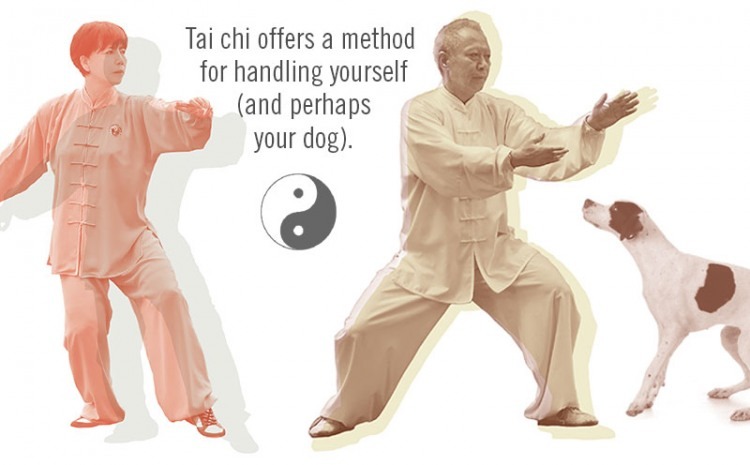Tai Chi And Dogs
Using an ancient mind-body exercise can provide a method for how to handle dogs.
By Christie Green, April 2018

It was a gorgeous day for a stroll down the animal shelterís tree-lined driveway with Hope, a 120-pound Mastiff, walking pretty as a picture at my side. I had been volunteering with homeless dogs like her to help them improve their manners and social skills. This gentle giant never needed help, but walking with her was a treat and a welcome break.
Until she launched after a mysterious temptation, nearly yanking me out of my skin. Letting go of the leash and admitting to the shelter staff that I lost her wasnít an option. Iíd rather be dragged to my death. After several leaps and bounds, I managed to get my feet back under me and pushed all of my weight and energy straight down. Thankfully, Hope stopped on a dime and didnít take off again.
Strength didnít create this happy outcome. In fact, what saved Hope (not to mention my pride) was something best known as an exercise for the elderly: tai chi.
Americans arenít alone in their confusion over tai chi, which is sometimes spelled as one word or as tai chi chuan (also appearing in places as one word), or as taiji or taijiquan. Language barriers aside, tai chiís evolutionary journey is as much the stuff of legend as it is fact, even among scholars. It could be as little as 300 years old, originating with the Chen family, or it could date back more than seven centuries. In any event, five families heavily influenced tai chiís course, branding it with their names. They include the famous Yang family, whose style is most widely practiced today.
Perhaps tai chiís most important shift, however, was from a fighting art to a mind-body exercise. In fact, tai chiís graceful, dance-like choreography originated as a martial art form. One of the ways tai chi differs from most other martial arts, however, is its strict attention to body alignment. This attention has a two-fold purpose: to create a kinetic chain with the body that maximizes power and to emphasize balance in any situation. The slow-motion practice helps solidify these alignments in the studentís muscle memory. Itís not a stretch to see how the same body alignments that focus on staying upright in a fight could help those who struggle to maintain balance on a daily basis.
Even though Iíve studied Yang style for some 18 years, the experience with Hope taught me that tai chi can help someone regain balance when struggling with a furry foe, too.
Here are a few Yang-style tai chi principles and some common situations in which they might prove useful. The last suggestion describes a way to practice these alignments without having to learn an entire tai chi form.
Using the waist for handling jumping dogs. Most people try to brace themselves against a jumping dogís incoming force; they usually end up getting knocked around. The tai chi student, on the other hand, doesnít meet incoming force head-on. She lets it sail past her with a turn of her waist. If a dog pushes on the right side, relax and let your waist rotate in that direction, moving like a revolving door. An important point to remember, however, is to move from the waist, not the hips, which can injure your knees.
Incorporating back muscles for bad leash manners. When youíre pulled, your bodyís center of gravity rises from the gut into the shoulders and chest area. Not only does that make regaining balance more challenging, it reinforces your dogís forward momentum. Pulling back from this awkward position pits your bicep muscle against every muscle in your dogís body. Good luck with that.
Tai chi offers three upper-body adjustments that could make a big difference. All three help to engage the large back muscles.
First, sink your shoulders. It should feel like the backs of your shoulders are melting down and rotating under and forward toward your armpits. If you work at a computer all day, your shoulders, neck and upper back probably need a lot of stretching to release tension.
Second, drop your elbows so they point down. Otherwise, movement initiates with the relatively smaller, comparatively weaker upper back and shoulder muscles.
Third, sink your sternum. Itís a tiny movement down and inward from the middle of the chest. This slight adjustment creates a rounded feelingówithout actually rounding your thoracic spineóacross the chest, shoulders and back, again helping to keep the big back muscles active and protecting the spine.
In combination, these three adjustments connect all of your powerful upper-body muscles into one team, which is better than relying on your arm muscle alone.
Weight shifting for pulling. According to your dog, all the best things in the world lie just beyond the reach of the leash. Donít pull back on the leash. Instead, stagger your feet, like you just took a big step, and shift about 60 percent of your weight from the front foot onto the back foot. Donít lean back; shift your hips and torso back as one unit, sinking your weight into your back foot like a one-legged squat, keeping enough weight in the front foot to use it as a brake. That way, youíre ďpulling backĒ with your body weight instead of relying on muscle alone.
Rooting for bad leash manners, or a jumper. Rooting is essentially pushing your weight and energy down into the earth, like the roots of a tree. You might even need to physically squat. When your dog starts pulling out of control, imagine all of your force shooting straight down into the ground. Thatís your root. And your dog will suddenly feel like heís pulling a tree. Itís the same for a jumper. Maybe he doesnít jump high enough for a waist rotation. Rather than be knocked over, root yourself down.
Relaxation, which is good for everything, but specially for improving reaction time. In tai chi, a tense body is a slow body. Tension slows down the circulation of blood and other bodily fluids to the working muscles (and, hence, vital components for energy production) and qi, the bodyís internal energy. Another speed bump for quick reflexes is the thinking process itself. In other words, in the time it takes to decide on a response, you could be already be responding. So, relaxing your muscles and quieting your mind can speed up your ability to act. Easier said than done, of course.
Meditation helps with this. Standing meditation may sound like an oxymoron, but itís a crucial component to tai chi training. Itís all about muscle efficiency and using only the necessary muscles while the rest relax. Stand with your feet a comfortable distance apartóthe closer they are, the more work it is to manage your balanceóand raise your arms in front of you as if holding a beach ball. From here, practice all of the adjustments previously mentioned: sinking shoulders, dropping elbows, sinking your chest, sensing your center of gravity, and rooting into the earth.
Obedience training goes a long way toward creating a safe, enjoyable relationship with our dogs. But for many people, training for only one end of the leash might not be enough. Tai chi takes practice, persistence and patience, not to mention a good instructor, but it could be the ancient secret to a life free of serious pet-related injuries.
Dig Deeper
Want to learn more about tai chi? Here are a few places to start.
The International Yang Family Tai Chi Chuan Association (yangfamilytaichi.com): the official organization of the Yang family descendants.
The Center for Taiji Studies (chentaiji.com): Founded by Dr. Yang Yang (no relationship to the Yang family above), the center promotes tai chi through research, presentations and teaching.
The National Center for Complementary and Integrative Health (nccih.nih.gov/health/taichi): a clearinghouse for trusted tai chi research and resources.
Article first appeared in The Bark, Issue 93: Spring 2018





 Reply With Quote
Reply With Quote
